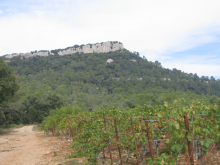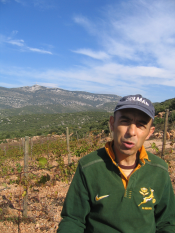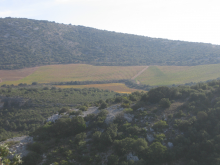There is a path in the southern France region of Languedoc, in the departement known as l’Herault, that leads up into the mountains of the Massif Centrale from a tiny village called Montpeyroux. When I lived there, more than a dozen years ago and ten years before I knew a thing about wine, I took this path as far as it  would go into a narrow, water-smoothed gorge. This gorge was about twenty meters deep, and is essentially consisted of a collection of dry basins and hollows in smooth rock that suggested that once, thousands or maybe millions of years ago, it was home to a waterfall. On its sensuous surface I learned to rock-climb over the course of several weeks, occasionally taking some hair-raising spills along the way, for which seasoned climbers upbraided me years later.
would go into a narrow, water-smoothed gorge. This gorge was about twenty meters deep, and is essentially consisted of a collection of dry basins and hollows in smooth rock that suggested that once, thousands or maybe millions of years ago, it was home to a waterfall. On its sensuous surface I learned to rock-climb over the course of several weeks, occasionally taking some hair-raising spills along the way, for which seasoned climbers upbraided me years later.
When I could finally make it to the top without falling, I discovered a small old vineyard planted with stunted bush vines planted in what looked to me like a rockpile, the most merciless, unforgiving limestone ‘soil’ I had ever seen. (I also discovered the road I might have taken to get there, rather than climbing.)
At the time I marveled that anything at all could grow in such a pile of rocks, and judging by the look of the vines–runty, forlorn, wearing the struggle of their existence in the knots and twists of their ancient limbs–I assumed the vineyard was on its way out, either dead or dying, a victim of its environment. What nutrients, what water source, what anything these old vines had to live on I wasn’t sure, but I knew that any fruit picked from these vines had to come at an extreme effort. It was, in effect, my first lesson in the resiliency of the grapevine to thrive in challenging environments–only later did I learn how important this was in producing great wine.
Last week I found myself on the same broad plain overlooking the gorge and staring at this amazing vineyard that not only had survived my early prognosis, but was bearing Carignane fruit ready for harvest.
I was there with Sylvain Fadat of Domaine d’Aupilhac, who is one  of a number of talented winemakers who are discovering the potential of these ancient hills for thrillingly modern wines. Fadat does not tend the vines that were the source of my epiphany, but he has planted a remarkable vineyard nearby called les Cocalières, on a steep plain above the ancient waterfall, facing Mont St. Baudille to the north. Set in a bizarre soil mixture of limestone, clay, and volcanics, Cocalières is his most thrilling terroir, and the wines from this site represent the sort of ‘new’ Languedoc that I could not locate the last time I visited and wrote about the region on this page, a year ago.
of a number of talented winemakers who are discovering the potential of these ancient hills for thrillingly modern wines. Fadat does not tend the vines that were the source of my epiphany, but he has planted a remarkable vineyard nearby called les Cocalières, on a steep plain above the ancient waterfall, facing Mont St. Baudille to the north. Set in a bizarre soil mixture of limestone, clay, and volcanics, Cocalières is his most thrilling terroir, and the wines from this site represent the sort of ‘new’ Languedoc that I could not locate the last time I visited and wrote about the region on this page, a year ago.
Languedoc remains the largest regional producer of wine in the world. That forest-for-the-trees condition certainly accounts for the initial difficulty I faced in finding wines of quality. But here in the shadows of mountains like St. Baudille, Pic Saint Loup, and l’Hortus, is a good place to hunt.
Geologically, it is a wonder. It’s the place where the Massif Central grinds to a halt and collapses into a plain rolling southward toward the Mediterranean. The mountains here don’t resemble peaks so much as tabletops, tilted into the sky and sheared off at the edges, leaving behind a rubble of geology wherein vines have been planted since Roman times. And even with that long history, it’s possible the best sites have yet to be discovered.
When Sylvain Fadat started making wine here in 1989, the sea of wine sourced from the broader Languedoc region showed little variation and few signs of quality. Now the hills of the l’Herault are emerging as some of the more diverse and remarkable terroirs in France–and yet the wines produced there remain among the most affordable.
There are some pronounced terroir differences as you travel east from Montpeyroux to Pic Saint Loup, most notably perhaps the fact that the latter place is protected from any maritime influence, while Montpeyroux is not. But there are many commonalities as well. One of the most vivid is the scent of ‘garrigue.’
Garrigue is the word given to the mélange of herbs, flowers, and other flora that grow wild in this region. Here in the hills it’s the  most concentrated, and it’s where the vines have found their home as well. They’re usually small and fairly isolated, dug into hills and carved out of this hardscrabble country and surrounded by corridors of wilderness and scrubland, where wild thyme, rosemary, and occasionally laurel are abundant. After a rain, which is when we saw Fadat, the scent is heady and magical, as if the entire country is being swathed in perfume. In contrast to Bordeaux or Burgundy, where the land surrounding the vineyards seems almost manicured, the landscape here is wild and scruffy.
most concentrated, and it’s where the vines have found their home as well. They’re usually small and fairly isolated, dug into hills and carved out of this hardscrabble country and surrounded by corridors of wilderness and scrubland, where wild thyme, rosemary, and occasionally laurel are abundant. After a rain, which is when we saw Fadat, the scent is heady and magical, as if the entire country is being swathed in perfume. In contrast to Bordeaux or Burgundy, where the land surrounding the vineyards seems almost manicured, the landscape here is wild and scruffy.
In the wines of the l’Herault, the garrigue is impossible to avoid. Nearly every wine seems to have a topnote of dried green herbs, of thyme and wild rosemary, grounding fruit-scents of fig and quince in the whites, and plum and blackberry in the reds. The herbal palette here seems very unique to the region, and fused with the fruit in an inimitable way, particularly in more aromatically neutral grapes like Rolle (Vermentino) and Carignane.
Winemaker Jean-Benoit Cavalier at Chateau de Lascaux in nearby Pic Saint Loup believes that post-veraison (the point in the growing season at which red grapes show pigmentation), the grapeskins possess special oils that collect and trap these scents, which is how the wines come to possess this haunting scent. To smell it in the glass is powerful, evocative, and completely unique to site–providing yet another reminder that terroir is an impossibly subtle, complex relationship between the vine and its environment en tous; earth, sky, and everything between.
Of course that same garrigue scent used to follow me in the hills where I walked and stumbled above the village of Montpeyroux all those years ago. I’m lucky; the memory of those days is available to me by simply opening a bottle. I recommend you do the same, and create a few memories of your own.
This roundup of specific wines below features only reds, which far outnumber the whites in this particular region (though there are many interesting whites in and around the l’Herault, most made from some combination of Vermentino, Marsanne, and Roussanne). Further south and east you encounter blends that employ Picpoul, Maccabeo, and Bourboulenc–a whole other world from the usual Rhône white varieties and their orbit.
Chateau de Lascaux, Coteaux du Languedoc (France) 2005 ($15, Kermit Lynch): A blend of Syrah, Mourvedre and Grenache, this inky red wine leads with a measure of Syrah’s meatier qualities, overlain with pretty violent florals. Its fresh and silky texture is ideal for barbecue. 87
Chateau de Lascaux, Coteaux du Languedoc (France) Pic Saint Loup ‘les Secrets’ 2001 ($25, Kermit Lynch): A single vineyard field blend of old vine Grenache and Syrah, this elegant wine is all about that old vine Grenache fruit, a mélange of black raspberries and wild herbs, with a sappy, briary taste marked by fine-grained, dark tannins. An aged beauty. 91
Chateau d’Aupilhac, Coteaux du Languedoc (France) Montpeyroux ‘les Cocalières’ 2005 ($30, Kermit Lynch): A blend of Grenache, Syrah, and Mourvedre, this wine is a grand statement of place, with its powerful scent of minerals and garrigue herbs overlaying a succulent black raspberry core of fruit. On the palate, it’s vinous and firm, the black cherry accented by tar and herb, with a gorgeous, mineral texture. Fadat says that the aromas of this wine are very consistent. 91
Chateau d’Aupilhac, Coteaux du Languedoc (France) Montpeyroux ‘la Boda’ 2004 ($36, Kermit Lynch): A blend of two terroirs, Mourvedre from Fadat’s Aupilhac vineyard outside the village, and Syrah from les Cocalières. Thus it’s the Mourvedre that grounds the wine with its piney scent and meaty flavor, but in the highland Syrah it seems you can taste the elevation, with a red raspberry streak that carries through to a juicy finish. 90
Chateau de Cazeneuve, Coteaux du Languedoc (France) Pic Saint Loup ‘Calcaires’ 2006 ($24, Langdon Shiverick): Syrah, Grenache, Cinsault and Carignane planted on what winemaker Andre Leenhardt refers to as ‘cold’ limestone soils, and indeed this shows a beautiful coolness to the aromas of purple flowers and thyme. The flavors are dark and plummy, with a gripping, peppery finish. 89
Chateau de Cazeneuve, Coteaux du Languedoc (France) Pic Saint Loup ‘les Roc des Mates’ 2005 ($35, Langdon Shiverick): A blend of Syrah, Mourvedre, and Grenache, which spends 18 months in neutral barrels, this lovely wine leads with a smoky, mineral scent, accenting cocoa and black currant. On the palate, it’s dark and spicy, with a rich dollop of cassis fruit, an elegant mouthfeel and loads of pepper spice on the finish. 90
Bergerie l’Hortus, Coteaux du Languedoc (France) Pic Saint Loup 2005 ($12, Beaune Imports): This straightforward, oak-free blend of Syrah, Grenache, and Mourvedre smells like a bowl of garrigue herbs in the warm sun, with a flavor that’s all Grenache, all the time–black raspberries and herbs. 89
Domaine de l’Hortus, Coteaux du Languedoc (France) Pic Saint Loup ‘Grande Cuvee’ 2004 ($25, Beaune Imports): A dark and meaty blend of Mourvedre, Syrah, and Grenache, this wine from the cool 2004 vintage has a meaty olive scent that gives way to more typical Syrah notes of white pepper and bacon fat. Its palate is impressively deep and dark, but a finely grained, round texture keeps the wine from plunging into the abyss. 91
